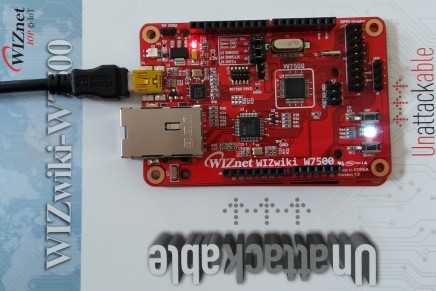What can you do with it?
The networking capabilities, the shield connectors and the micro SD card slot make the board a perfect platform for web servers, IoT devices and other cabled web-connected devices that store and/or serve data. The hardwired TCP/IP stack - or TCP/IPCore Offload Engine (TOE) as it is called in the datasheet – allows for up to eight sockets simultaneously and also provides WOL (Wake on LAN) for low-power applications.

According to the cardboard inlay the board is “unattackable”, which suggests that the applications of the WIZwiki-W7500 are to be sought in IoT and secure networking. Why the board is unattackable is not really explained, but it probably refers to the fact that the TCP/IP stack is hardwired. This may make attacks more difficult, but it is only a part of the application which, of course, is only as secure as its weakest link.

The Arduino shield extension connectors make it easy to plug some compatible third-party extension board on the WIZwiki-W7500. There are many of these shields around, and it is likely that the function you need is already available in this format. There is one thing to keep in mind though and that is the shield I/O voltage. Indeed, the WIZwiki-W7500’s shield connectors are wired for 3.3 volts operation because the MCU runs from 3.3 volts. According to the W7500 datasheet, the MCU can handle I/O voltages of 5 volts (and even a bit more than that), but it is not clear if this is valid all the time (5 V tolerant) or only when the supply voltage is 5 volts too.

According to the cardboard inlay the board is “unattackable”, which suggests that the applications of the WIZwiki-W7500 are to be sought in IoT and secure networking. Why the board is unattackable is not really explained, but it probably refers to the fact that the TCP/IP stack is hardwired. This may make attacks more difficult, but it is only a part of the application which, of course, is only as secure as its weakest link.

The Arduino shield extension connectors make it easy to plug some compatible third-party extension board on the WIZwiki-W7500. There are many of these shields around, and it is likely that the function you need is already available in this format. There is one thing to keep in mind though and that is the shield I/O voltage. Indeed, the WIZwiki-W7500’s shield connectors are wired for 3.3 volts operation because the MCU runs from 3.3 volts. According to the W7500 datasheet, the MCU can handle I/O voltages of 5 volts (and even a bit more than that), but it is not clear if this is valid all the time (5 V tolerant) or only when the supply voltage is 5 volts too.
Read full article
Hide full article


Discussion (0 comments)